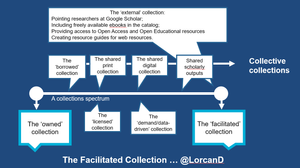A few things about library collection shifts came to my attention this week … Taken together, they underline several central trends: the move to electronic, the managing down of print collections, and the curation of institutionally-generated learning and research resources.
Cloud-sourcing collections
Rick Anderson has a typically pointed post about Cloud-sourcing Research Collections: Managing Print in the Mass-digitized Library Environment [PDF] a report from OCLC Research prepared by Constance Malpas. Constance notes that the emergence of the mass digitized corpus of books at Google Books and Hathi Trust has the potential to transform the academic library.
Rick responds, and highlights the urgency of some of the points made in the report.
I would put it much less cautiously than that — the emergence of a mass-digitized book corpus cannot fail to transform the academic library enterprise. The extent of the transformation will depend on several factors, of course, including the content and accessibility of the corpus — but librarians’ opinions about the mass-digitization program will have no effect at all.
What should cause concern for academic libraries is the fact that such a corpus already exists, and is growing by the day; the dam holding it back is fragile and cracking. There is already a steady flow of water through the breaches in that dam (existing search functionality in Google Book Search; the quickly growing Hathi Trust collection), and the dam will give way entirely when some version of the Google Book Settlement is approved. …
… After reading this report, my confidence in the long-term viability of traditional collection-building has been undermined even further. The library of the future is not going to look much like a library. We librarians need to swallow hard, let go of some of the things we love most about our jobs, and prepare ourselves — now — for the inevitable (and probably precipitous) arrival of what is behind that dam. // The digitized book corpus and the cracking dam
Some of Rick’s thoughts on collection shifting can be found in a presentation he recently gave at the Ontario Library Association Super Conference where he shared a platform with my colleague Karen Calhoun.
The Cloud-sourcing research collections report has received a lot of attention as it begins to provide an empirical and service framework within which to think about managing down print collections, a growing trend across libraries.
This theme was addressed at the RLG Partnership Meeting last year by David Lewis of IUPUI. The powerpoint [pptx] and audio [mp3] of his presentation have been conveniently put together by Peter Murray:
Against an interesting environmental analysis, David presented the outline of academic library strategy as follows:
- Complete the migration from print to electronic collections
- Retire legacy print collections
- Redevelop library space
- Reposition library and information tools, resources, and expertise
- Migrate the focus of collections from purchasing materials to curating content
Inside-out collections
His presentation on this occasion focused on the lines in bold. In discussing a stronger emphasis on curating institutional content (point 5), he referenced a distinction I have made between ‘inside out’ and ‘outside in’ (here and here):
Think, for example, of a distinction between outside-in resources, where the library is buying or licensing materials from external providers and making them accessible to a local audience (e.g. books and journals), and ‘inside-out’ resources which may be unique to an institution (e.g. digitized images, research materials) where the audience is both local and external. Thinking about an external non-institutional audience, and how to reach it, poses some new questions for the library. // Outside-in and inside-out
This need for attention to ‘inside out’ is also picked up in a nicely done overview of collection development trends, Turning collection development inside out, by Dorothea Salo:
Coincidentally, this was to be presented at the OLA Super Conference also, but weather prevented attendance.
Note: Cosmetic updates on 31 March 2021 to fix spacing and broken links and to add headings.



